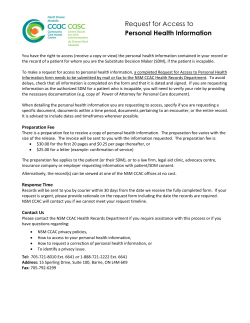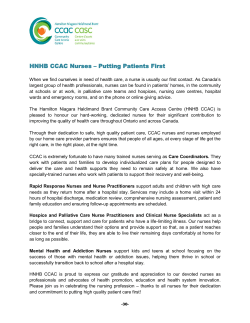
Read the North East CCAC 2015/2016 Quality Improvement Work
2015/16 Quality Improvement Plan for North East CCAC "Improvement Targets and Initiatives" AIM Quality dimension Measure Objective Safety To reduce falls among long-stay home care clients Effectiveness To reduce the number of unplanned ED visits among home care clients Source / Measure/Indicator Unit / Population Period Percentage of adult % / Adult long HCD, RAI-HC long-stay home care stay home care via LSAS / Oct clients that have a fall clients 1, 2013 - Sept on their follow-up RAI30, 2014 HC Assessment Percentage of home % / Home Care care clients with an Clients unplanned, lessurgent ED visit within the first 30 days of discharge from hospital 2015/16 Quality Improvement Plan for North East CCAC HCD, DAD, NACRS / Jul 1, 2013 - Jun 30, 2014 Current performance 36.8 14.3 Target 35.3 13.8 Change Planned improvement Target justification initiatives (Change Ideas) Acuity of patients is 1)Increase use of the Home increasing faster Safety Risk Assessment as a than the provincial health teaching tool with rate. Falls patients about safety of the prevention home environment. programs are in place but volume of patients exceeds capacity of program. In rural and isolated areas, small hospital Emergency Dept are used as walk-in clinics for primary care by the populations they serve. There are 21 small hospitals in the NE CCAC area. 1)Collaborate with at least one hub hospital and one small hospital to understand the underlying causes of unplanned ED visits by CCAC patients and to develop strategies that support patient's care needs in the home. Methods Process measures A monthly CHRIS report will be produced for review and analysis by the Falls Prevention Committee and the Quality, Risk and Patient Safety Committee on the percentage of completed Home Safety Risk Assessments completed in that period. Percentage of completed Home Safety Risk Assessments for long-stay patients receiving an inhome assessment. Monthly ED Notification Reports will be analyzed and reviewed by the designated work group (hospital and CCAC)for accuracy and to discover cause(s) of unplanned ED visits over a period of 3 to 6 months (to be determined by the work group). Number of accurate monthly reports available for review and analysis by the designated work group (hospital and CCAC). Goal for change ideas 80% of patients receiving a RAI-HC during a one month period, have a completed Home Safety Risk Assessment noted in CHRIS. Completed analysis outlining root cause(s) of patients returning to the ED during the designated period with preliminary ideas for improvement. Comments Determine baseline for future improvement initiatives Enable development of shared change ideas to prevent re-occurrence. 1 of 3 AIM Quality dimension Access Measure Source / Objective Measure/Indicator Unit / Population Period To reduce avoidable Percentage of home % / Home Care HCD, DAD, hospital admissions care clients who Clients NACRS / Jul 1, among home care experienced an 2013 - Jun 30, clients unplanned 2014 readmission to hospital within 30 days of discharge from hospital To reduce service wait times Current performance 20.5 Target 18.2 5 Day Wait Time % / Home Care Personal Support for Clients Complex Patients: % of complex patients who received their first personal support service within 5 days of the service authorization date. Ministry of Health Portal / Oct 1, 2013Sept 30, 2014 84.2 84.8 5 Day Wait Time % / Home Care Nursing Visits: % of Clients patients who received their first nursing visit within 5 days of the service authorization date. Ministry of Health Portal / Oct 1, 2013Sept 30, 2014 93.7 94 2015/16 Quality Improvement Plan for North East CCAC Change Planned improvement Target justification initiatives (Change Ideas) Focus on 1)Collaborate with at least understanding this one hub hospital and one metric and its small hospital to understand drivers as we work the underlying causes of toward reaching the avoidable hospital provincial average. readmissions by CCAC patients and to develop strategies that support patient's care needs in the home. Goal for change Comments ideas Monthly Reports of unplanned Number of accurate monthly Completed analysis Enable shared hospital readmissions will be reports available for review outlining factors development of analyzed and reviewed by the and analysis by the contributing to change ideas. designated work group designated work group hospital (hospital and CCAC)for (hospital and CCAC) and one readmissions during accuracy and to discover final summary report. the designated time cause(s) of these readmissions period with over a period of 3 to 6 months development of (to be determined by the work preliminary ideas group). for improvement. Methods Process measures Target is consistent 1)Understand contributing with provincial factors causing delays over 5 average. days to delivery of first personal support service to complex patients. Conduct monthly chart audits of a sample of patient charts over a period of 3 to 6 months where the 5-day wait time was not achieved for review by stakeholders and committees. Between 3 and 6 monthly chart audit reports are prepared and submitted to stakeholders and committees. Monthly chart audit results and analysis are completed and shared with relevant stakeholders and committees for identification of opportunities for quality improvement. Achieve results consistent with provincial average. Conduct monthly chart audits of a sample of patient charts over a period of 3 to 6 months where the 5-day wait time was not achieved for review by stakeholders and committees. Between 3 and 6 monthly chart audit reports are prepared and submitted to stakeholders and committees. Monthly chart audit results and analysis are completed and shared with relevant stakeholders and committees for identification of opportunities for quality improvement. 1)Understand contributing factors causing delays over 5 days to delivery of first nursing service to patients. 2 of 3 AIM Quality dimension Client-centred Measure Objective To improve client experience Source / Measure/Indicator Unit / Population Period Percent of home care % / Home Care OACCAC / Apr clients who Clients 1, 2013 - Mar responded "Good", 31, 2014 "Very Good", or "Excellent" on a fivepoint scale to any of the client experience survey questions: i) Overall rating of CCAC services ii) Overall rating of management/handlin g of care by Care Coordinator iii) Overall rating of service provided by service provider Current performance 92.4 Target 90 Change Planned improvement Target justification initiatives (Change Ideas) Maintain result in 1)Support Care Coordinators this range. and Clinical Services staff with engagement with patients, family members, and others in difficult conversations about changes in health care needs and other difficult topics. 2)Increase staff awareness of patient experience with NE CCAC services. This will be achieved through structured communication to all staff and dissemination of reports, analysis of Key Performance Indicators to improvement teams, management teams, operational and board committees. Methods Goal for change ideas 30% of staff who interact with patients complete the E-learning modules "Communicate with H.E.A.R.T." by March 31, 2016. A quarterly progress report of the percent of staff uptake of the education module will be provided to management staff and also be included in the Quality, Risk and Patient Safety Report. Percentage of staff who interact with patients who complete the education module Survey of staff to assess level of awareness of patient experience and use of data in development of strategies to improve patient experience. # of staff indicating increased awareness of CCEE and use of survey results in their work to improve patient experience. 50% of staff responding to the survey will agree that they are more aware of patient experience with NE CCAC services by March 31, 2016. A document describing the Patient and Family Engagement Strategy is vetted with stakeholders for review by the Board of Directors. The Patient and Family Engagement Strategy is finalized and approved by the Board of Directors by March 31, 2016. 3)Development of a Patient Patient and Family and Family Engagement Engagement Strategy is Strategy developed in accordance with Accreditation Canada standards and best practice and with review and input by the Quality, Risk and Patient Safety Committee, the Patient Services and Quality Committee of the Board of Directors and other stakeholders. 2015/16 Quality Improvement Plan for North East CCAC Process measures Comments Education / skill development strategy implemented. Supports a culture of patient engagement. 3 of 3
© Copyright 2025

















